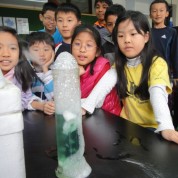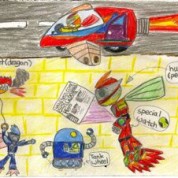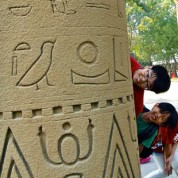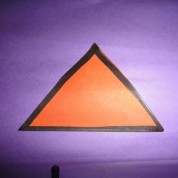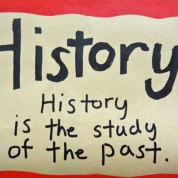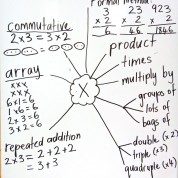Halloween? We call it Science!
Today, we had a very exciting interruption to our day! Mrs Trussler, the Secondary School Science teacher, told us that a delivery of dry ice had arrived at school. How exciting! We raced upstairs to the Science lab for a wonderful lesson on states of matter. We watched in awe as the dry ice behaved differently in the air, on the table, in water and in a soap mixture. We learned that dry ice is actually solid carbon dioxide, which has frozen at a temperature of -78 degrees Celsius. We learned about solids, liquids and gases. We even watched the process of sublimination right before our eyes. We loved popping bubbles of carbon dioxide! Dry ice makes spooky smoke at Halloweeen….but today, it was Super Science for Grade 4! Thank you, Mrs Trussler, for adding so much to our learning. Halloween Science on PhotoPeach What did you learn about states of matter? What other substances do you know that change from a solid to a liquid to a gas? Can you explain sublimination?...
Read MoreDescribe the future in 100 words.
As we study ancient history, we have taken the opportunity to review concepts of past, present and future. While we research the lives of ancient people, we’ve also had fun imagining the lives of future generations. Our creative writing prompt this week came from the City Kids & Parents Magazine. What will the world be like in 100 years? Here are a few of our 100-word descriptions: 100 Years in the Future Now, let’s narrow our thinking to the next decade: What do you hope your life will be like in 10 years? What do you think the environment will be like in 10 years? What will you do to make the world a better place over the next decade?...
Read MoreWandering through the Ancient World
Today, we left our classroom and wandered through the ancient world. (Well, almost!) We spent the day at World Park, hunting for ancient architecture. With a map and a team, we navigated our way through ancient China, Rome, Egypt and Greece. We found, touched and climbed on replicas of many famous buildings. Our favorites were the pyramids, the Parthenon, the Colosseum and the Trojan Horse. We made notes about interesting features and discussed the ratio of size between the replica and the real buildling. We have learned that architectural legacies can be seen in many modern buildings. Ancient Architecture on PhotoPeach Keep reading and thinking: Have you seen any modern buildings with Greek columns? Why was the Trojan Horse built? How and why did the Egyptians build...
Read MoreGeometry Hunters: Ancient Greek legacies in our school!
Did you know that the ancient Greeks made lots of mathematical discoveries? This week, we have been looking at ancient architecture and learning about lines, angles and 2D shapes. We still use ancient Greek geometry in our art, architecture, music and games today. In small groups, we hunted for geometry around our school. We earned a point for every mathematical legacy we could find, name and measure. Here is a group of Geometry Hunters and their findings: What did you learn about the properties of 2D shapes this week? Why is mathematics important in architecture? Why is mathematics important in...
Read MoreStep Back In Time!
This week we are very excited to start our new unit on ancient civilisations! We have been poring over books, asking questions and sharing our prior knowledge. We’ve also started reading a hilarious series of adventure books called the Time Warp Trio. Historical fiction lets us meet gladiators, mummies and emperors through fascinating stories. We are excited have a set of Kindles for our classroom reading, so we can download relevant books instantly! Here’s Hyun Seo reading a factual book: We already love studying history! Soon, we will begin in-depth research into a civilisation of our own choice. People might choose to explore ancient Egypt, Greece, Rome or China. Today we learned some important vocabulary for our unit: We also asked a big question: Why do we study history? There are so many answers to this question! Why do you think history is an important area of study? Why do you find history...
Read MoreMultiplication Madness!
Groups of, bags of, lots of, doubles, triples, products….it’s multiplication madness in Grade 4 this week! We’ve been looking at all the ways to think about, represent and calculate multiplication. We’ve used arrays of objects, drawings, number sentences and formal algorithms. We’ve discovered that memorising our times tables really helps! We’ve had speed competitions to find products, totals and differences. Each team works out their own strategies and the winners are constantly changing. We’ve also had fun writing math problems about events from camp. For example, if there were 17 sticks and 12 marshmallows on each stick, how many marshmallows were there in total? We are very good at using all four operations (+, -, x, /) in word problems now. Here we are solving each others’ word problems: Some people in our class have such a good understanding of formal algorithms, they can work with algebra. Stay tuned for interesting word problems and their solutions! Add your own word problem for a friend to solve....
Read More


